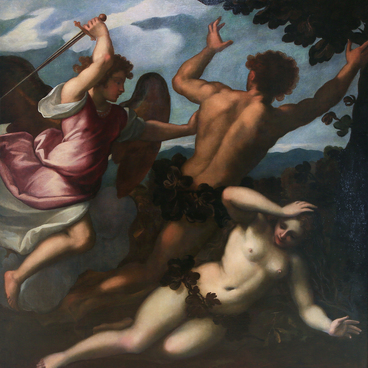Philipp Peter Roos came from a dynasty of German painters. He was born in Frankfurt am Main, Germany, in 1657. He learned to paint from his father, the founder of the dynasty, the Baroque era landscape painter and etcher Johann Heinrich Roos. He continued to improve his skills under the guidance of the Italian painter Giacinto Brandi. Later, he received the new surname “Rosa di Tivoli” after the town of Tivoli, near Rome, where the artist lived after completing his studies. In 1683, Philipp Peter Roos joined the Pope’s Guild of Painters.
Johann Roos specialized in pastoral idylls with animals, in particular — goats and sheep. Following in the footsteps of his father, Philipp preferred subjects involving animals. He also worked in the genres of landscape and still life.
The color palette in the paintings by Philipp Peter Roos is somewhat somber due to the active use of a heavy brown tone. At the same time, his paintings are characterized by an interesting subject matter and composition as well as great draftsmanship. They are displayed in Dresden, Vienna, and Kassel Art Galleries, and the State Hermitage Museum.
“Goats at a Broken Tree” from the collection of the Primorye State Art Gallery represents the animalistic genre in 17th-century painting. Animalier art became an independent genre in Europe only in the 16th century and gained popularity in the 17th century. Artists of this genre focused on depicting animals and in doing so intended to achieve not only scientific accuracy but also a keen perception of the animals’ peculiarities.
In the foreground of the painting “Goats at a Broken Tree”, Philipp Peter Roos depicted three goats by the water. He detailed their hair, including its texture, making every animal different from the others. It may take the viewer some time before they will notice the small figure of a shepherd who has sat down among his flock in the background. The animals are integrated into a picturesque landscape: behind them is a tree with small leaves that has been broken, possibly, during a storm, and sunlit clouds rise from the low horizon.
Johann Roos specialized in pastoral idylls with animals, in particular — goats and sheep. Following in the footsteps of his father, Philipp preferred subjects involving animals. He also worked in the genres of landscape and still life.
The color palette in the paintings by Philipp Peter Roos is somewhat somber due to the active use of a heavy brown tone. At the same time, his paintings are characterized by an interesting subject matter and composition as well as great draftsmanship. They are displayed in Dresden, Vienna, and Kassel Art Galleries, and the State Hermitage Museum.
“Goats at a Broken Tree” from the collection of the Primorye State Art Gallery represents the animalistic genre in 17th-century painting. Animalier art became an independent genre in Europe only in the 16th century and gained popularity in the 17th century. Artists of this genre focused on depicting animals and in doing so intended to achieve not only scientific accuracy but also a keen perception of the animals’ peculiarities.
In the foreground of the painting “Goats at a Broken Tree”, Philipp Peter Roos depicted three goats by the water. He detailed their hair, including its texture, making every animal different from the others. It may take the viewer some time before they will notice the small figure of a shepherd who has sat down among his flock in the background. The animals are integrated into a picturesque landscape: behind them is a tree with small leaves that has been broken, possibly, during a storm, and sunlit clouds rise from the low horizon.



